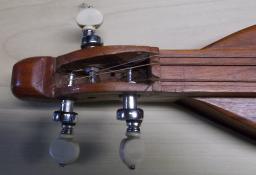John Tignor dulcimer rework
Instruments- discuss specific features, luthiers, instrument problems & questions
A young couple came to my home yesterday with a beautiful old Tignor dulcimer that had some problems. The fist thing I noticed is that it bore a striking resemblance to an Uncle Ed Thomas dulcimer. I think John was a protege of Jethro Amburgey, wasn't he? Anyway, I brought my latest Thomas upstairs and laid it next to their dulcimer. Apart from the Tignor being a couple inches longer and slightly wider, they looked like twins.
The 3 tuners on it were shabby-looking planetary models, inexpertly mounted by somebody, and all 3 strings were the wound steel ones we use just for bass drones. I found reference photos of what Tignor pegs should look like, and set about to reproduce them in old-growth black walnut. They came out very well. I then went to string the dulcimer with the proper gauge strings, when I noticed the "mile-high" action. The tone is nice, but pushing the melody string all the way down to the staple fret really stretches it out of tune! I'm not sure if I should lower it or leave it as-is. Any thoughts, my fellow historical luthiers?
updated by @john-c-knopf: 10/27/19 12:02:25PM




